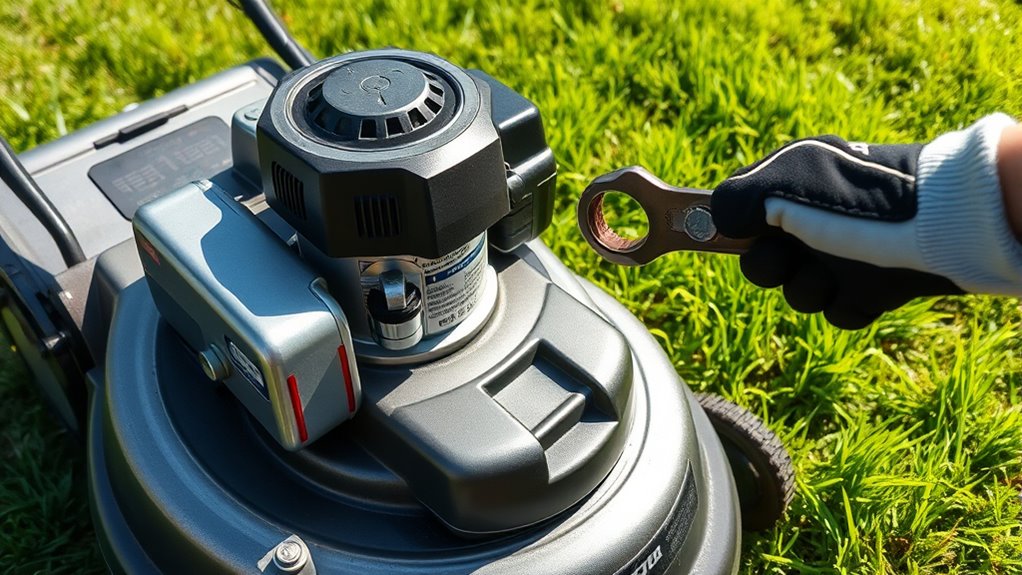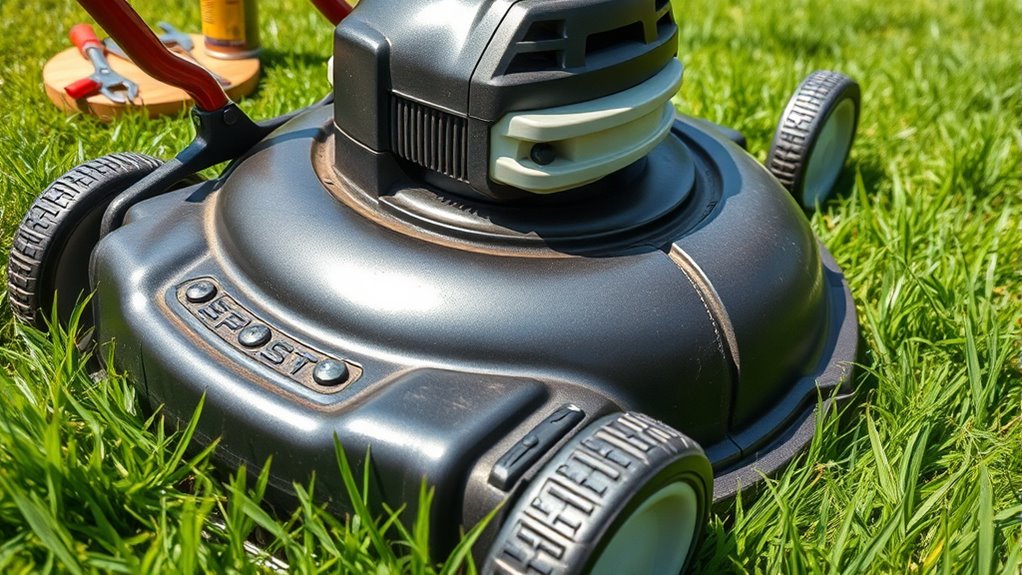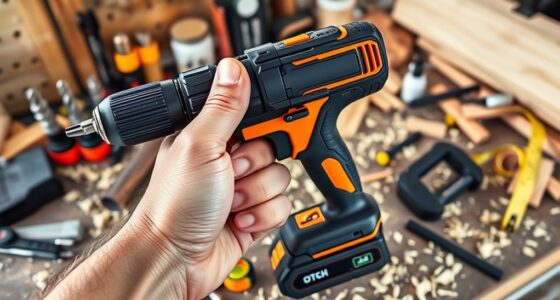To maintain your lawn mower, regularly change the oil every 25–50 hours of use, ensuring you warm up the engine first. Check and clean or replace the air filter monthly, and inspect the spark plug annually, tightening and gapping it properly. Keep blades sharp, balanced, and clean after each use. Don’t forget to inspect belts and keep the fuel fresh or drained for storage. Keep up with these steps to keep your mower running smoothly — there’s more to learn ahead.
Key Takeaways
- Regularly check and change the oil every 25–50 hours of use or annually to keep the engine running smoothly.
- Inspect and replace or clean the air filter monthly, ensuring proper sealing to prevent debris entry.
- Use manufacturer-specified fuel, refuel when cool, and consider stabilizer for storage to maintain fuel quality.
- Sharpen blades every 20–25 hours of use, check for damage, and balance after sharpening for optimal cutting.
- Inspect and replace spark plugs annually, and check drive belts for wear, cracks, or fraying, replacing as necessary.

Are you keeping your lawn mower in top shape? Regular maintenance is key to guaranteeing it runs smoothly and lasts for years. Start with oil changes; you should do this every 25 to 50 hours of use or at least once a year. Before draining the oil, warm the engine for 2 to 3 minutes. This makes the oil flow more easily. Place a drain pan under the oil drain plug, remove it carefully, and let all the oil drain out. If your mower has an oil filter, replace it before refilling with fresh oil. Use the manufacturer-recommended oil type and quantity. Check the dipstick after filling to prevent overfilling, which can lead to engine trouble. Proper oil maintenance not only prolongs engine life but also improves overall mower performance.
Regularly change your mower’s oil every 25–50 hours or yearly for optimal performance.
Next, inspect your air filter monthly, especially during heavy use periods. Remove the filter and look for dirt buildup or damage. Foam filters can be cleaned with soap and water, then dried and lightly oiled before putting back. If you have a paper filter that’s clogged or damaged, replace it. Proper sealing of the filter is vital to prevent debris from entering the engine, which could cause significant damage.
Fuel management is equally important. Always use the fuel type specified by your mower’s manufacturer. When refueling, make sure the engine and tank are cool to avoid vapor lock or fire hazards. Open the fuel cap slowly to release pressure gradually. Use a funnel to avoid spills, and consider adding a fuel stabilizer if you plan to store the mower for a long period. Alternatively, drain the fuel tank completely to prevent fuel degradation.
Blade maintenance keeps your cuts clean and your mower efficient. Check the blades regularly for dullness, cracks, or bends. Sharpen them every 20 to 25 hours of use, and replace blades that are excessively worn or damaged. After sharpening, balance the blades to prevent engine vibrations. Clean the blades after each use to prevent rust and grass buildup, which can cause imbalance and reduce cutting efficiency.
Spark plugs should be replaced annually or after about 100 hours of use. Remove the spark plug with a socket wrench and inspect it for fouling or corrosion. If it’s still in good shape, clean it with a wire brush. Set the gap precisely to the manufacturer’s specifications, usually around 0.030 inches, and tighten gently to avoid thread damage. This guarantees reliable ignition and smooth engine performance.
Finally, check the belt and drive system regularly. Look for cracks, fraying, or glazing. Follow your mower’s manual for removing and inspecting belts. Replace worn or damaged belts promptly to keep power transmission smooth. During installation, ensure the belts are aligned with pulleys correctly. After replacing belts, test the mower’s operation to confirm it runs quietly and efficiently. By following these steps consistently, you maintain your lawn mower running well and extend its lifespan, making mowing easier and more effective. Additionally, staying informed about AI and automation developments can help you adapt your maintenance routines with the latest tools and technologies.
Frequently Asked Questions
How Often Should I Replace My Lawn Mower’S Spark Plug?
You should replace your lawn mower’s spark plug once a year for peak performance, especially if you use it regularly. If you have a heavy workload or commercial use, consider replacing it every six months. Watch for signs like difficulty starting, poor engine performance, or decreased fuel efficiency. Regular checks and proper installation help keep your mower running smoothly, ensuring you don’t face unexpected problems during your yard work.
What Type of Oil Is Best for My Lawn Mower?
Choosing the right oil for your mower is like picking the perfect fuel for your car; it keeps things running smoothly. If you mow in warm weather, SAE 30 works well, but for all-season performance, SAE 10W-30 is better. Synthetic oil offers top protection in extreme temps but costs more. Always check your manual to match the oil with your engine’s needs and warranty requirements.
How Can I Prevent Rust on My Mower Blades?
To prevent rust on your mower blades, you should regularly clean and dry them after each use. Remove any grass or debris with a plastic putty knife or nylon brush, then rinse thoroughly. Apply rust-preventive coatings like WD-40, silicone spray, or non-stick cooking spray to create a protective barrier. Store your mower in a dry, covered area, and consider painting the underside of the deck for extra protection.
Is It Necessary to Sharpen Mower Blades Regularly?
Is it necessary to sharpen mower blades regularly? Absolutely, just like a chef sharpens their knives to keep precision, you need to maintain your blades for a perfect cut. Regular sharpening ensures your mower cuts cleanly, promoting a healthy lawn and preventing damage. Typically, sharpen after 20-25 hours of use or when you notice dullness. Skipping this step leads to tearing grass, increased stress on your mower, and an uneven, less attractive yard.
What Safety Precautions Should I Follow During Maintenance?
During maintenance, you should always wear protective gear like gloves and goggles to guard against sharp blades and debris. Make sure the mower is on a level surface, and disconnect the spark plug to prevent accidental starting. Keep children and pets away, work in a well-ventilated area, and avoid working under the deck with the engine running. Follow safety guidelines to prevent injuries and guarantee safe maintenance.
Conclusion
By regularly tending to your lawn mower, you’re nurturing a loyal steed that’ll carry you through countless green adventures. Think of your mower as a trusted companion—when you give it the care it deserves, it’ll return the favor with a flawless cut and reliable performance. Keep it well-oiled, sharp, and clean, and you’ll guarantee your yard’s beauty endures like a well-tended garden of memories. With each maintenance, you’re weaving a story of care and craftsmanship.










